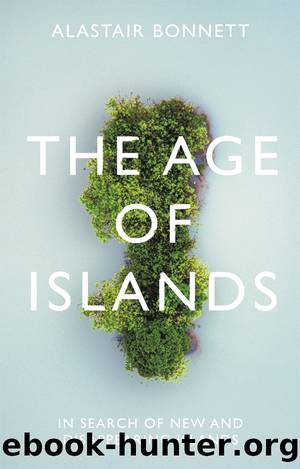The Age of Islands by Alastair Bonnett

Author:Alastair Bonnett
Language: eng
Format: epub
Publisher: Atlantic Books
THE ACCIDENTAL ISLANDS OF PEBBLE LAKE, HUNGARY
Why am I hunting for islands in landlocked Hungary? The nation’s capital, Budapest, is 542 kilometres from the nearest salt water but I’m intrigued by pictures of a flooded gravel quarry in a southern suburb. It is dotted with islands and has been given the name Pebble Lake. Aerial photographs show the islands have a central green space and a circumference clotted with tiny self-built houses; from the air they look like eccentrically arranged but complete sets of teeth gnashing at the water.
Pebble Lake is an example of a distinct category of artificial island: the accidental island – a side effect of human activity. Like many quarries, this one was only partially dug out. Tall pillars of rock were left standing. It was then abandoned and, because it’s deeper than the local water table, it filled with water. The result was a scatter of islands encircled by deep cold water.
The planet’s biggest example of an accidental island is René-Levasseur Island. If you type that name into Google Earth you may be in for a surprise. At 72 kilometres wide, it is a very large – and, from high up, very circular – island that looks like a big button dropped on Quebec’s northern expanses. One of the biggest objects ever created by Homo sapiens, René-Levasseur was an unintended consequence of the flooding of its surrounding land in order to make a reservoir. It is on the opposite end of the scale to Pebble Lake but they are distant cousins and I’m hoping my visit to Kavicsos-tó (the Hungarian for ‘Pebble Lake’) could be a gateway into this intriguing subspecies of island.
Pebble Lake is a thirty-minute drive from the centre of Budapest. I put the co-ordinates into the satnav and it doesn’t take long for the affluent city of palaces and pavement jazz musicians to slide away into a dusty edge-land of grey blocks and car fumes. I steer across an arm of the divided Danube onto Csepel Island. Somewhere at its northern end is Pebble Lake. At 48 kilometres long, Csepel is one of the Danube’s largest islands (the biggest is in Slovakia and stretches 84 kilometres) and was once the heartland of Hungarian heavy industry. From what I can see through my increasingly dirty windshield, Csepel is now a post-industrial dumping ground, a sprawling mix of anonymous housing blocks and semi-derelict areas. Perhaps I am prejudiced by the grisly news item I clicked on a few nights before, which named Csepel as the place mobsters and paramilitaries bury their victims alive. In 2011 four bodies were unearthed, all of whom had met this end. It is suspected that the island is the lonely resting place of others. It feels a long way from Budapest’s most famous island, Margaret Island, a beautiful park that lies in an affluent reach of the river. I was walking there only yesterday: happy in the hot July sunshine, enjoying the good-natured crowds, the carefully clipped flowerbeds and a delicate cone of lemon sorbet.
Download
This site does not store any files on its server. We only index and link to content provided by other sites. Please contact the content providers to delete copyright contents if any and email us, we'll remove relevant links or contents immediately.
| Historic | Information Systems |
| Regional |
Man-made Catastrophes and Risk Information Concealment by Dmitry Chernov & Didier Sornette(4728)
The Revenge of Geography: What the Map Tells Us About Coming Conflicts and the Battle Against Fate by Kaplan Robert D(3596)
Zero Waste Home by Bea Johnson(3285)
COSMOS by Carl Sagan(2944)
In a Sunburned Country by Bill Bryson(2941)
Good by S. Walden(2909)
The Fate of Rome: Climate, Disease, and the End of an Empire (The Princeton History of the Ancient World) by Kyle Harper(2429)
Camino Island by John Grisham(2379)
A Wilder Time by William E. Glassley(2358)
Organic Mushroom Farming and Mycoremediation by Tradd Cotter(2304)
Human Dynamics Research in Smart and Connected Communities by Shih-Lung Shaw & Daniel Sui(2174)
The Ogre by Doug Scott(2105)
Energy Myths and Realities by Vaclav Smil(2054)
The Traveler's Gift by Andy Andrews(2007)
Inside the Middle East by Avi Melamed(1937)
Birds of New Guinea by Pratt Thane K.; Beehler Bruce M.; Anderton John C(1905)
Ultimate Navigation Manual by Lyle Brotherton(1763)
A History of Warfare by John Keegan(1712)
And the Band Played On by Randy Shilts(1612)
